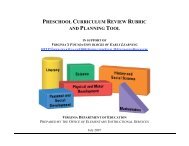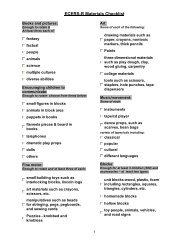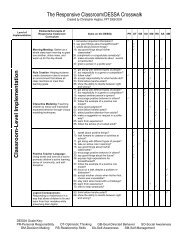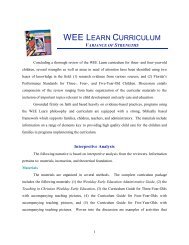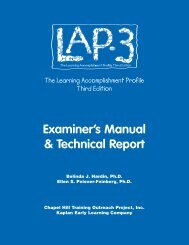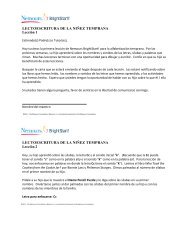Examiner's Manual & Technical Report - Kaplanco.com
Examiner's Manual & Technical Report - Kaplanco.com
Examiner's Manual & Technical Report - Kaplanco.com
- No tags were found...
Create successful ePaper yourself
Turn your PDF publications into a flip-book with our unique Google optimized e-Paper software.
Types of Assessment ResultsStandard scores. The LAP-D yields two primary types of information. First, the LAP-Dprovides standard scores based on normative data, including percentile ranks, Z-scores, T-Scores, Normal Curve Equivalents (NCE), and age equivalent scores. These scores allow for<strong>com</strong>parisons of skill levels between subscales/domains and help users understand a child’s skilldevelopment in <strong>com</strong>parison with other children of similar age and characteristics. Because of thediffering number of items in each subscale, raw scores cannot be <strong>com</strong>pared from one subscale toanother in a meaningful way. However, standard scores use a <strong>com</strong>mon range regardless of thenumber of items or the developmental age range. For example, a standardized score enables theteacher to <strong>com</strong>pare the similarity and/or difference between the child’s performance on onesubscale, such as Fine Motor: Writing to another subscale, such as Gross Motor Object:Movement.Standard scores are useful in determining broad areas or domains in which the child may behaving difficulty or in which a child excels. Such information may be useful in identifyingchildren with serious developmental delays or children needing special intervention. The LAP-Dprovides normative information about a child’s performance which, when used as a part of amulti-disciplinary assessment, may assist parents and professionals in making decisions aboutthe need for early intervention and the provision of special education and related services. Inaddition, such information may help teachers with planning and determining goals for classroominstruction.Specific developmental skill data. A second type of information that may be obtained fromLAP-D assessment results is specific developmental skill data. By reviewing the scoring ofindividual items within the subscales, the evaluator or teacher may identify skills a child hasmastered, emerging skills, and those skills that are beyond a child’s current developmental level.Items that were administered but not demonstrated by the child may serve as a basis foridentifying specific short-term objectives for the instructional program. The information derivedfrom the analysis of individual items may be converted into instructional objectives. Suchbehavioral descriptions derived or adapted from the assessment results provide an excellentfoundation for an individualized instructional program. Such information is also useful for thedevelopment of an Individual Education Program (IEP) or an Individualized Family Service Plan(IFSP) for children with disabilities. The LAP-D cards may be used for reinforcing skilldevelopment indicated in IEP or IFSP objectives.Completing the Scoring Summary & ProfileAll normative tables for standard scores are contained in the appendices of this manual. On theScoring Summary & Profile, columns have been provided for entering the percentile rank, ageequivalent, and standard z-scores, depending on which scores are desired on the summary. Thefollowing suggestions are provided to assist the examiner in <strong>com</strong>pleting the Scoring Summary &Profile. In addition, <strong>com</strong>puter-based software is available that can generate all the information onthe Scoring Summary & Profile, as well as provide individualized goals and objectives forindividual children along with options for reports at the classroom, parent, and site levels. To31




